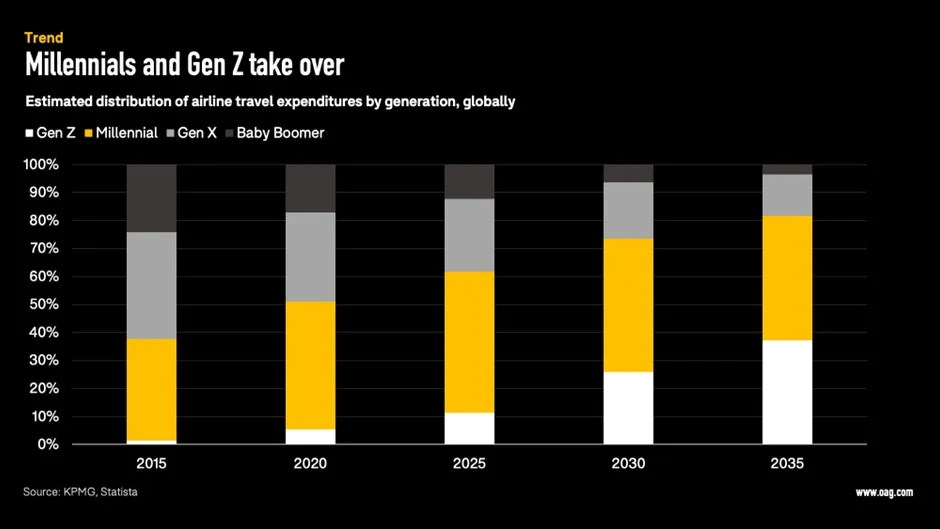
Yurik Schwab, Head of Hardware Systems at Ink, explores the shift toward digital-native airport journeys.
For decades, airports have been built around large, fixed hardware: check-in counters and kiosks. These systems were designed for a time when travel was analogue, linear, and staff-heavy. But the way people move—and expect to move—has changed.
The next generation of passengers thinks differently. They expect travel to work the way the rest of their digital lives do: smooth, fast, personal, and paperless. And yet, much of today’s airport infrastructure still revolves around standing in line, printing documents, and interacting with outdated machinery.
This mismatch isn’t just inconvenient—it’s unsustainable, operationally and environmentally. And for the aviation industry, it’s becoming impossible to ignore.
The rise of digital-native travellers
Millennials and Gen Z already account for over 50% of air travel spending, and by 2035, they’ll represent a staggering 80% of all airline expenditures. This generation doesn’t need to be taught how to use mobile check-in or digital IDs—they expect them.
More than 75% of Millennial and Gen Z travellers use smartphones to plan and manage their journeys. Nearly half of them book travel entirely on mobile, and 75% use mobile boarding passes. For these passengers, the idea of queuing to print anything feels like a step backwards in time.

Digital fluency is now a strategic imperative. If airport experiences don’t keep up, this generation of travellers will increasingly choose airlines and hubs that do.
The real cost of heavy infrastructure
Traditional airport equipment is not only outdated—it’s expensive. A single self-service kiosk can cost up to $20,000, not including installation, which can add up to the cost depending on location. Maintenance over five years often totals 30% of the original cost, including ongoing service calls and parts replacement.
And what’s the ROI? Many of these machines sit idle and are only marginally utilised even when passenger volumes are high. For airports trying to optimise operational performance, reduce costs, and maximise the use of valuable floor space, these numbers no longer make sense.
Worse still, every square metre taken up by hardware is space that could generate revenue through retail, food and beverage, lounges, or other passenger experiences, like kids' play areas.
Sustainability: From printouts to digital
Beyond costs, there’s a growing environmental case against physical infrastructure. The aviation industry is under mounting pressure to reduce its carbon footprint—and that means more than fuel optimisation.
Each year, aviation relies on billions of single-use bag tags, paper receipts, and boarding passes. Mobile technology already eliminates much of this. Now, the same transition is happening in baggage. Paper tags and plastic holders are among the most wasteful, single-use components of the journey. It is not common knowledge that bag tags have a thin plastic film bonded to the paper - just try to rip one after your next journey. Electronic bag tags (EBTs) allow passengers to tag their bags in advance, removing the need for in-airport printing. They are reusable, digital, and integrated into modern check-in flows.
With over 50% of Gen Z and 48% of Millennials willing to pay more for sustainable travel options, the business case for digitising baggage is no longer just operational — it’s strategic.
The answer: Software-first passenger journeys
The industry doesn’t need more kiosks or terminals—it needs fewer. That’s the idea behind ZERO by Ink Innovation, which reimagines passenger processing as a software-first experience. Built around compact components that are barely visible and flexible architecture, it removes reliance on heavy hardware infrastructure and enables truly touchless journeys.
Check-in, ID checks, bag drop, and boarding are no longer separate stops—they become parts of one continuous, intuitive flow. Agents can serve passengers on the move. Airlines can customise their setup based on space, demand, and passenger profile. With no dependence on bulky installations, deployment is faster and more affordable.
Data:
- OAG Traveller Survey 2024 [source]
- Euromonitor International’s Voice of the Consumer: Lifestyles Survey 2024 [source]







